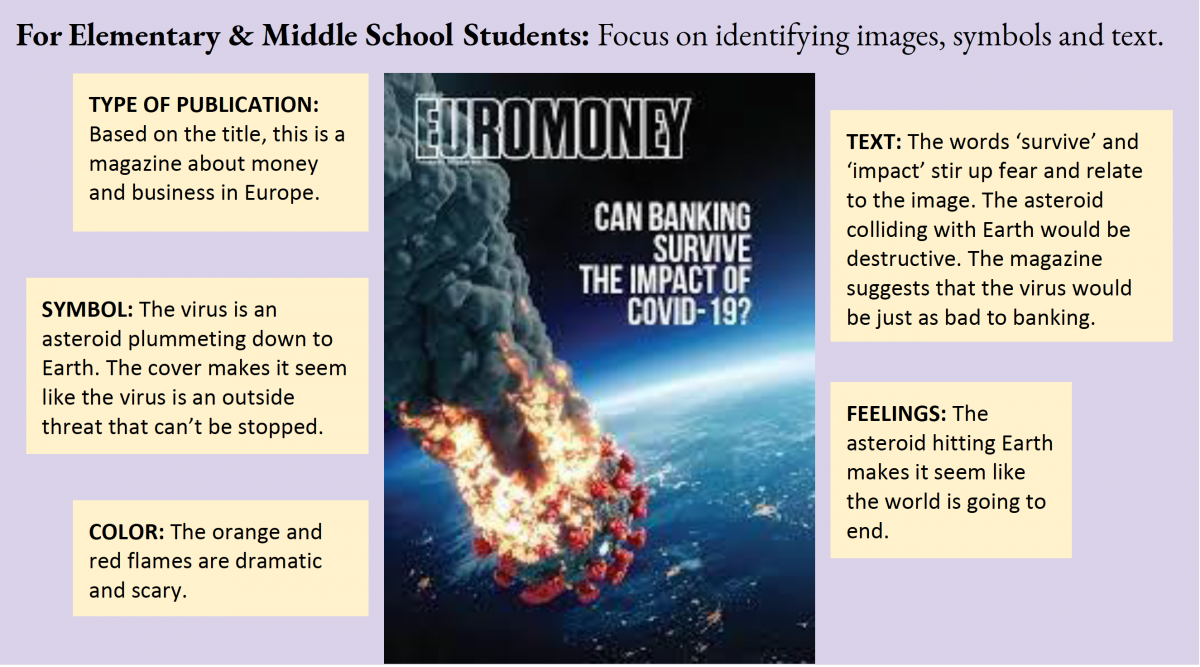Now in Spanish and English!
Students of all ages can develop media literacy competencies in this fun and engaging lesson, which includes adaptations for both online and face-to-face learning. Watch the video to get an orientation to the lesson:

Learners will:
- Strengthen visual analysis skills with special attention to multimodal features including text, images and design;
- Understand, use and apply concepts in media literacy, including audience, authorship, representation, meaning and message, to specific examples;
- Activate critical thinking in considering how the coronavirus epidemic is being represented in media.
NEW! Download the PDF Lesson Plan in Spanish!
Learning Process
- Introduce the activity by asking students how they have seen the Covid-19 pandemic represented in the media they’ve consumed: TV, social media, memes, magazines, advertisements, etc. Are there any messages that stood out in particular?
- Access Frank Baker’s magazine cover collection and ask students whether they’ve seen similar images either at home or online.
- Review media literacy concepts and vocabulary to understand one or more of the theories of media literacy
- Apply the terminology in a group magazine analysis to model the activity, discussing one cover together as a class and asking questions to guide student interpretation and demonstrate close reading.
- Direct students to choose a magazine cover from the collection and analyze the cover, applying 1 or 2 media literacy concepts.
- Reflect on the activity as a group. Ask students: How does this activity change the way they feel about these images? How does your magazine cover differ from others? What can you learn about magazine audiences and authors from these examples?
Technology
This activity was first modeled by the Media Education Lab with MURAL, a interactive digital whiteboard designed for collaboration. Learn about MURAL here and view a template for this lesson’s workspace here. You might also use a class blog; a shared Google Doc/Slides on which students post their work and leave comments; screen-sharing over a video conferencing platform. This lesson works as a shared class time activity, or asynchronously by having students complete the activity independently and leave comments on other student work.
Working with All Grade Levels
This activity can be modified for elementary, middle and high school classes.
- Elementary School: Use this activity to build media literacy vocabulary. Spend time going over keywords, distinguishing between a magazine and an advertisement, and identifying images, words and symbols.
- Middle School: Have students demonstrate their knowledge by making their own magazine covers. Assign them a magazine title, and have them create a cover that would appeal to their audience through graphics and text.
- High School: Apply critical media literacy skills, thinking about power, information, and the commercial side of magazines.
Examples
Students create visual displays to demonstrate their ability to interpret and analyze coronavirus magazine covers using media literacy concepts.


Create to Learn
Compose a magazine cover with Adobe Spark
I've Got it Covered: Creating Magazine Covers to Summarize Texts (Read, Write, Think, NCTE)
Learn More
The Spiky Blob Seen Around the World: How Medical Illustratrators Created the Coronavirus' Most Iconic Image. The New York Times, April 1, 2020.
Kids are Drawing Pictures of the Coronavirus. That's a Good Thing. Bulletin of the Atomic Scientists.
--This lesson was developed by Frank Baker, Sarah Clapp, and Renee Hobbs


